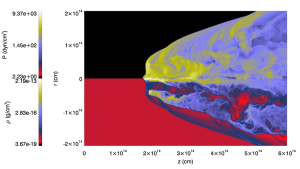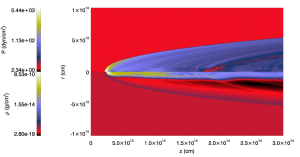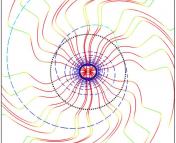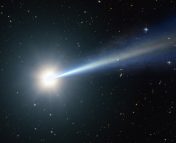Paper title: Clouds and red giants interacting with the base of AGN jets
Authors: V. Bosch-Ramon, M. Perucho, M. V. Barkov
First author’s affiliation: Dublin Institute for Advanced Studies
Active Galactic Nuclei (AGN) contain within them a supermassive black hole that accretes matter and produces a highly energetic jet of material that moves away from the black hole at relativistic speeds. The powerful nature of these jets suggest that you would not want to be in the line of fire. Today’s paper begins to answer the question: “What if you were?” Previously, related studies analytically considered the effects on emission, propagation, and content of the jets after an (unfortunate) object had entered. In this paper, the authors set out to investigate the effects that the jet would have on the object as it passed through the jet through numerical simulations.

Figure 1: The two scenarios. a) A red giant with detached external layers enters the jet. b) a homogeneous cloud of matter enters the jet.
Two situations are considered that both involve the entrance of an obstacle into the jet. For the first situation the obstacle is a red giant, having an inhomogeneous density profile described by the power law (with a solid core). The second situation introduces a homogeneous obstacle, which may represent a dark, wandering cloud of gas. For both cases, magnetic interactions between the jet and the obstacle have been neglected, making this a very basic model, but one that can still shed light on the basic processes involved.
Several 2-dimensional, axisymmetric simulations were conducted for both cases. The simulated jet was matter-dominated, consisting of protons and electrons and the obstacle always entered perpendicular to the direction of jet flow. The total kinetic power of the jet differed slightly for every simulation, ranging from 2 – 3.5 x 10^44 erg / s .

Figure 2: Combined maps of pressure (top) and density (bottom) at t ~ 1.1 x 10^6 seconds for the homogeneous situation.
Situation 1: The Matter Cloud (homogeneous)
Immediately upon entering the jet, a bow shock forms. What happens next depends on the speed of the shocked obstacle. If it’s moving fast enough so that the jet-crossing time is less than the characteristic time of bow shock formation, then the shocked obstacle will escape the jet. If it’s crossing time is more than that characteristic time, the shocked obstacle will be dragged along with the jet, disrupted and eventually mixed with the jet material. The jet delivers an enormous amount of energy to the obstacle, causing it to heat up and expand, increasing the interaction cross section. At t ~ 7 x 10^5 seconds, turbulent mixing between the obstacle and the jet begins to occur. This mass flux into the jet may significantly affect the jet’s momentum.

Figure 3: Combined map of pressure (top) and density (bottom) at t ~ 1.8 x 10^6 seconds for the inhomogeneous situation.
Situation 2: The Red Giant (inhomogeneous)
Initially, the behavior is quite similar to situation 1. A bow shock forms immediately and material is dragged downstream with the jet. The shock travels around the core and carries a large clump of matter away with it. This bulk mass is the gaseous outer layer of the obstacle and can be seen propagating with the jet in Figure 3 as a small bump near z = 2.0 x 10^14 cm. The layers of the red giant below the photosphere are not heavily effected during the simulation. Much of the mass remains intact, hindering turbulent mixing between the obstacle and the jet. Due to the radial decrease in density, the obstacle does not expand as quickly as in the homogeneous case, which makes for a much smoother shock and less mixing between the obstacle and the jet material.
The authors intend to continue this work and extend their models to incorporate both magnetic field and 3-dimensional effects.




